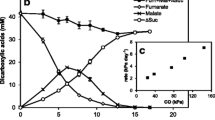Abstract
The active species of “CO2”, i.e. CO2 or HCO -3 , formed in the CO dehydrogenase reaction was determined using the pure enzyme from the carboxydotrophic bacterium Pseudomonas carboxydovorans. Employing an assay system similar to that used to test for carbonic anhydrase, data were obtained which are quite compatible with those expected if CO2 is the first species formed. In addition, carbonic anhydrase activity was not detected in P. carboxydovorans.
Similar content being viewed by others
References
Bray RC, George GN, Lange R, Meyer O (1983) Studies by e.p.r. spectroscopy of carbon monoxide oxidase from Pseudomonas carboxydovorans and Pseudomonas carboxydohydrogena. Biochem J 211:687–694
Cooper TG, Filmer D, Wishnick M, Lane MD (1969) The active species of “CO2” utilized by ribulose diphosphate carboxylase. J Biol Chem 244:1081–1083
Funakoshi S, Deutsch HF (1968) Human carbonic anhydrases. I. Isolation and demonstration of isozymes in erythrocytes. J Biol Chem 243:6474–6481
Lindskog S (1960) Purification and properties of bovine erythrocyte carbonic anhydrase. Biochim Biophys Acta 39:218–226
Meyer O (1982) Chemical and spectral properties of carbon monoxide: methylene blue oxidoreductase. The molybdenum-containing iron-sulfur flavoprotein from Pseudomonas carboxydovorans. J Biol Chem 257:1333–1341
Meyer O (1985) Metabolism of aerobic carbon monoxide-utilizing bacteria. In: Poole RK, Dow CS (eds) Microbial gas metabolism. Mechanistic, metabolic and biotechnical aspects. Academic Press, London, pp 131–151
Meyer O, Fiebig K (1985) Enzymes oxidizing carbon monoxide. In: Degn H, Cox RP, Toftlund H (eds) Gas enzymology. Reidel, Dordrecht, pp 147–168
Meyer O, Rohde M (1985) Enzymes oxidizing carbon monoxide. In: Degn H, Cox RP, Toftlund H (eds) Gas enzymology. Reidel, Dordrecht, pp 147–168
Meyer O, Rohde M (1984) Enzymology and bioenergetics of carbon monoxide-oxidizing bacteria. In: Crawford RL, Hanson RS (eds) Microbial growth on C1 compounds. American Society for Microbiology, Washington, pp 26–33
Meyer O, Schlegel HG (1978) Reisolation of the carbon monoxideutilizing hydrogen bacterium Pseudomonas carboxydovorans (Kistner) comb. nov. Arch Microbiol 118:35–43
Meyer O, Schlegel HG (1979) Oxidation of carbon monoxide in cell extracts of Pseudomonas carboxydovorans. J Bacteriol 137: 811–817
Meyer O, Schlegel HG (1980) Carbon monoxide: methylene blue oxidoreductase from Pseudomonas carboxydovorans. J Bacteriol 141:74–80
Meyer O, Schlegel HG (1983) Biology of aerobic carbon monoxide-oxidizing bacteria. Annu Rev Microbiol 37:277–310
Wilbur K, Anderson NG (1948) Electrometric and colorimetric determination of carbonic anhydrase. J Biol Chem 176:147–154
Author information
Authors and Affiliations
Rights and permissions
About this article
Cite this article
Futo, S., Meyer, O. CO2 is the first species formed upon CO oxidation by CO dehydrogenase from Pseudomonas carboxydovorans . Arch. Microbiol. 145, 358–360 (1986). https://doi.org/10.1007/BF00470871
Received:
Accepted:
Issue Date:
DOI: https://doi.org/10.1007/BF00470871




